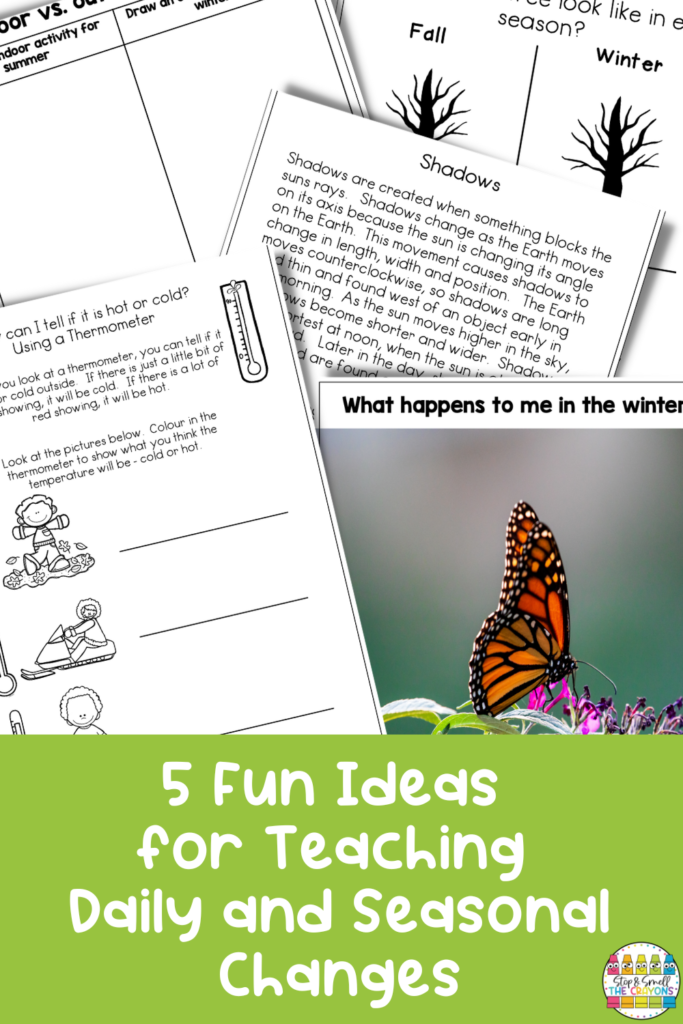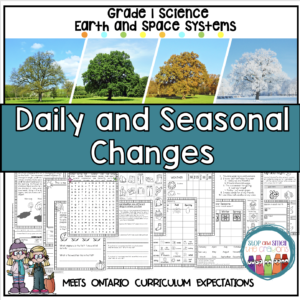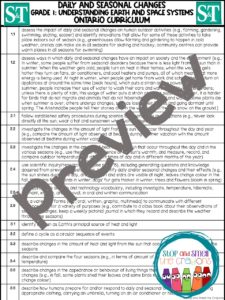Does teaching Daily and Seasonal Changes strike fear in your soul? If it does, then it’s probably because resources are scarce on this topic or your school has limited science materials. But I have good news for you today! Teaching this science topic does not need to involve expensive science materials. Just your imagination and the great outdoors! Let’s make Daily and Seasonal Changes one of your favorite Grade 1 science units to teach with these fresh, easy-to-implement ideas!
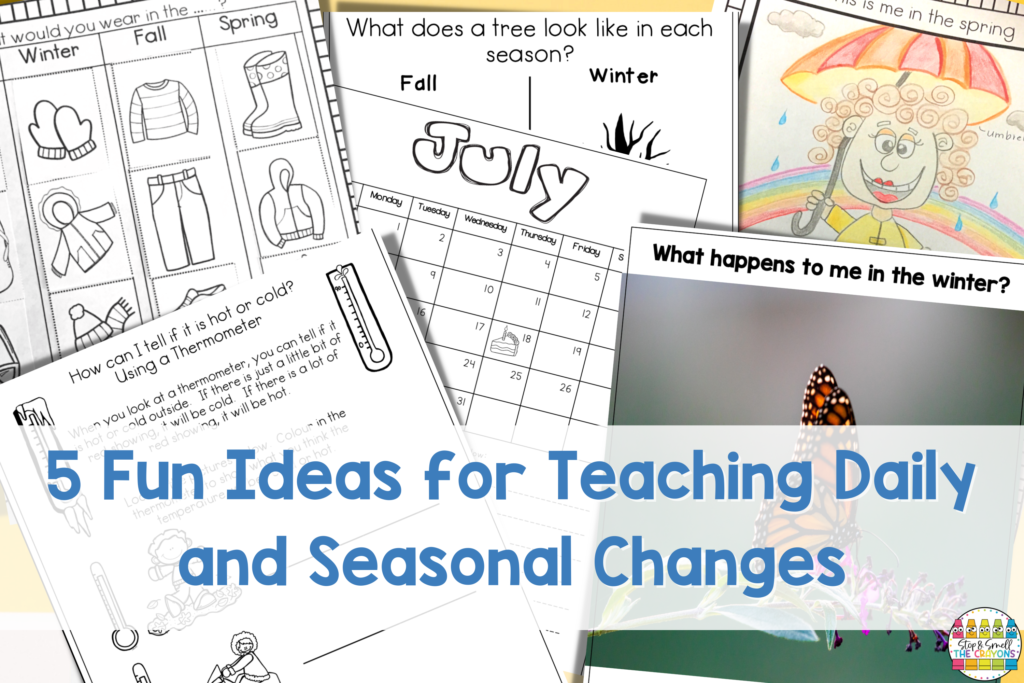
1. Integrate Seasonal Changes into Your Daily ELA Block
As a teacher, you have a front-row seat when introducing your students to the fascinating world of Daily and Seasonal Changes.
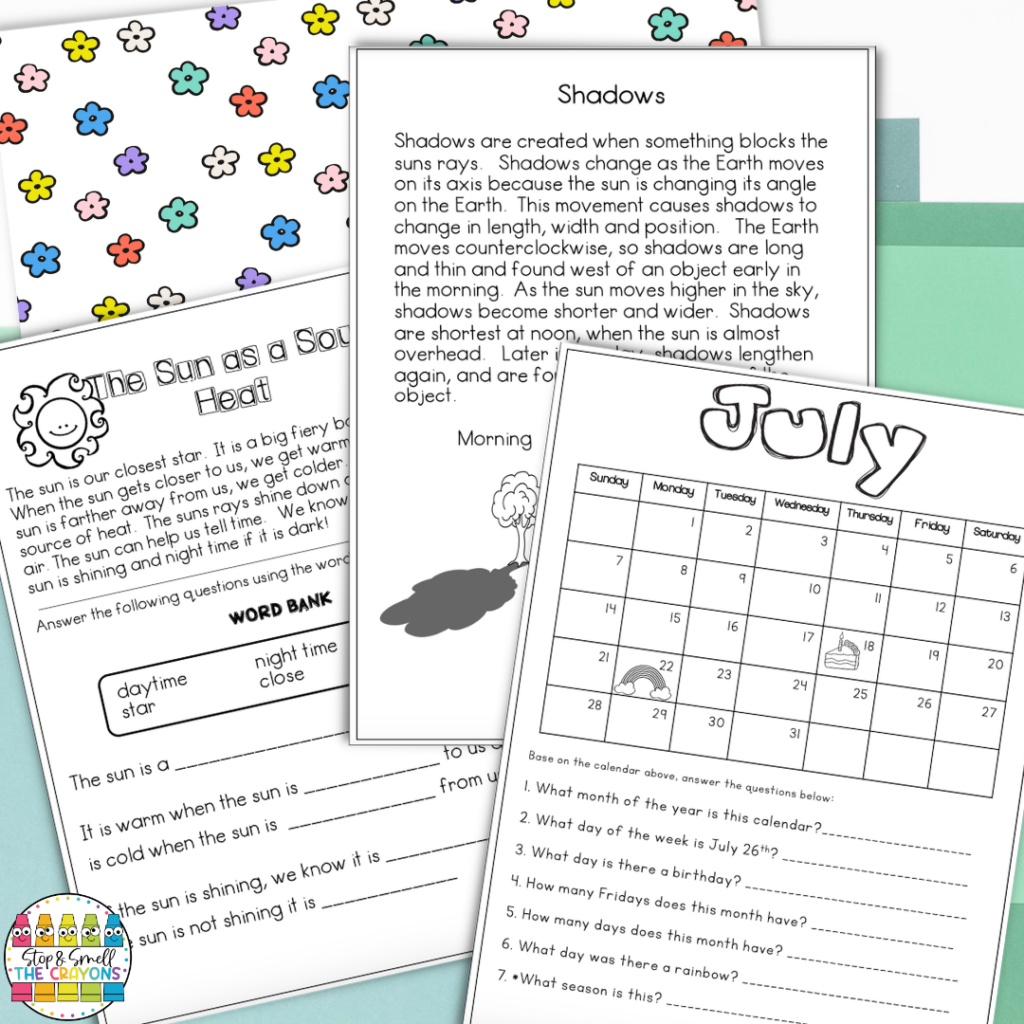
Helping them understand these changes not only feels magical but sparks their curiosity about the world around them and begins building the foundation for scientific thinking.
I also like to show my students that the concept of Daily and Seasonal Changes is a part of our everyday lives, not just science class.
Integrating this topic with my Reading and ELA block helps students connect their scientific learning to the real world. They also begin to understand that we can learn to read and write the words we are learning about. They also realize that they can read books to learn more information.
Here are several easy ideas for integrating Seasonal Changes into your ELA time:
- Teach the four seasons during your calendar time. Singing songs and watching short Youtube videos during this time helps students understand the differences between seasons. Reading poems (Choral Reading style) and chanting the months of the year, days of the week, and seasons help improve students’ sight vocabulary and fluency.
- Use illustrated vocabulary cards of Season related terms to create a class Word Wall. Have students read aloud several words each day until they can read them in text.
- Use journal prompts related to the seasons for their daily writing activities.
- Teach about the setting and writing with different seasons as the focus.
- Include reading/looking at seasonal and science-related books and science-based writing tasks in your Daily Five or ELA Centers.
- Share fun read-alouds about seasons with your students. I like A Tree For All Seasons by Robin Bernard.
I have some pretty amazing activities that incorporate Reading in my Four Seasons and Seasonal Changes 1st Grade Science Unit! Illustrated Vocabulary Cards, Months of the Year printables, and short paragraphs with comprehension questions are just a few of the activities you can easily integrate into any ELA block!
2. Connect Seasonal Changes to Your Math Lessons
Math and Science truly do go hand in hand! In fact, I think it’s harder to separate Math and Science than it is to teach them together. Get the most bang for your Science buck by using seasonal changes-themed activities in your Math class!
Here are my favorite ways to do this:
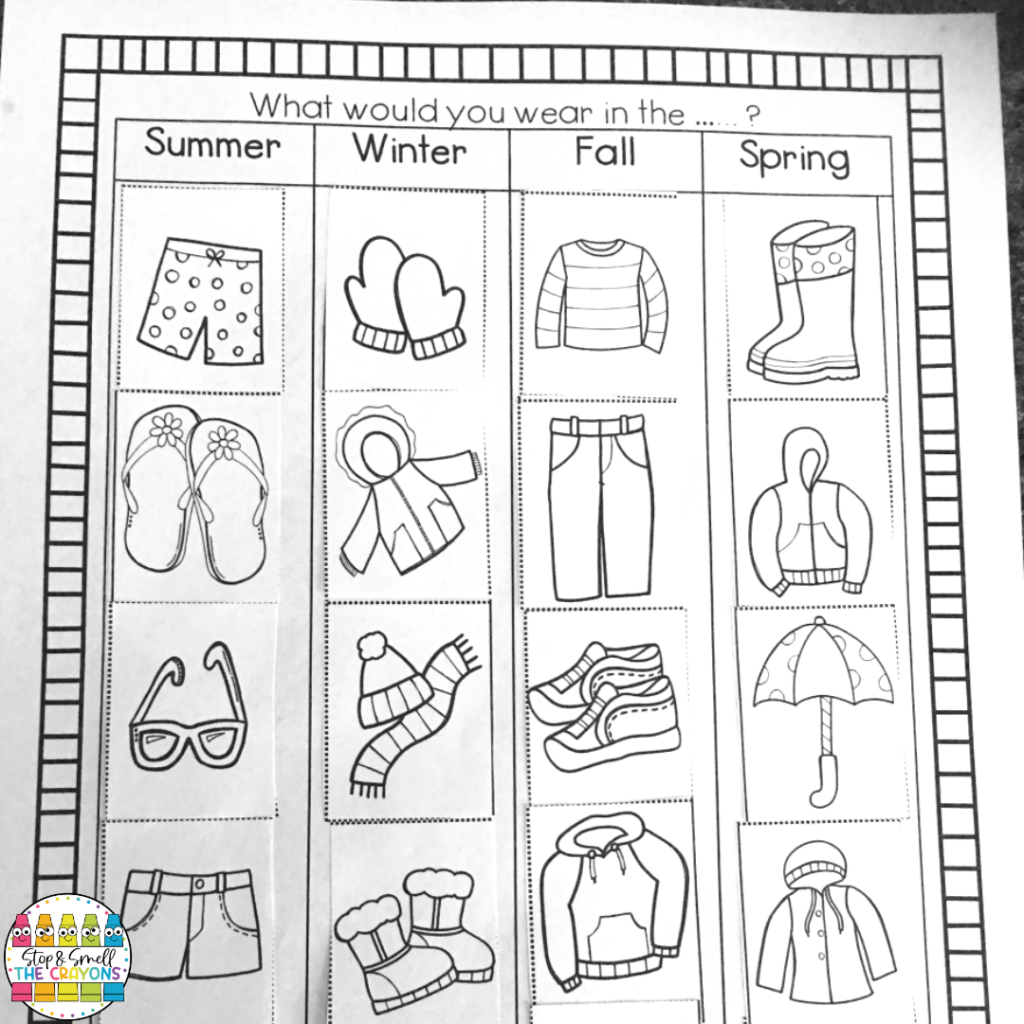
- Use S.T.E.M challenges like building a home for a frog in the winter that will withstand the temperatures and provide shelter for survival.
- Create math word problems for the math skill you are learning with a scientific twist! For example, if you’re studying money, write problems where students have to add how much a winter hat and gloves cost, etc…
- Have students measure shadows when teaching measurement.
- Use thermometers to show different temperatures in the various seasons.
- Graph the number of winter items that the students in the class are wearing. Count who’s wearing mittens, boots, snow pants, a hat, etc…
If you’re kind of stuck on how to get started incorporating Daily and Seasonal Changes into your Math class, you really should check out the activities in my Four Seasons and Seasonal Changes 1st Grade Science Unit! Printable shadow measuring pages, seasonal shelter discussions, and cut and glue seasonal clothing sorting activities are fun and simple ways to help students better understand seasonal changes while also reinforcing important math skills!
3. Use the Seasons to Create Works of Art
Incorporating daily and seasonal changes into your art lessons is so very important! By doing this, you will encourage creativity, build your students’ observation skills, and connect students to the world around them. Art is an excellent way to teach students about the changing seasons and how they affect us.

By allowing them to create art that reflects Daily and Seasonal Changes, students learn to appreciate the beauty of their surroundings while thinking creatively and putting their scientific knowledge into practice. When students are able to express their ideas and imagination through art, they develop critical thinking skills that extend beyond the classroom!
A few fun ways to add Art to your Scientific learning are:
- Have students draw, paint, or use paper to create works of art that show different activities for each season.
- Ask students to create images of themselves dressed appropriately for each season.
- Give students time in class or as an outside-of-class project to create a diorama to show how an animal changes during the seasons (a bear hibernates, a squirrel collects food, etc…).
- Take students for a walk to collect Fall leaves. Have students make leaf rubbings in the beautiful Fall colors they observed.
- Allow students to draw winter scenes in chalk on a black piece of construction paper.
- Show students this YouTube video of pictures of Vincent Van Gogh’s flower paintings. Have them draw spring flowers using Van Gogh’s paintings as inspiration.
I do like to make sure that before we jump into creating art, my students have a strong understanding of the concept from which to draw. Using the lesson plans and printable pages from my Four Seasons and Seasonal Changes 1st Grade Science Unit, you are sure to teach your students exactly what they need to know in order for them to accurately reflect their knowledge of the seasons through art!
4.Take Learning Outside
Admit it… You knew I was going to say, “Go outside!” didn’t you? Of course, I would say this! Going outside is the perfect way to help your students understand Daily and Seasonal Changes.

By observing the environment outside, students can witness firsthand how weather and seasons affect plants, animals, and the landscape. They will also notice changes such as the leaves changing colors in the fall or flowers blooming in the spring.
Hands-on activities such as collecting natural materials like leaves, flowers, or pinecones will help students make connections between what they see and what they feel.
Allowing your students to experience changes in the natural world using their senses will deepen their understanding of Seasonal Changes. Plus, it’s amazing watching their eyes light up when they notice or recognize something we’ve learned about!
Here are a few easy ideas for activities you can do outside:
- Teach shadows outside. Allow students to draw their shadows as well as the shadows of different items at different times of the day. Watch how the sun moves and changes the position of the shadows.
- Search for different animals in different seasons. Discuss how they change or act differently depending on the season.
- Discuss appropriate clothing to dress in and go outside to be protected from the elements in each season.
- Build a shelter to protect yourself from the sun, wind, or other types of weather.
- Choose a tree on the playground to observe. Draw it in each season and discuss how it changed.
If you love the idea of taking your students outside but are a little unsure of what to do once you get there, check out the resources in my Four Seasons and Seasonal Changes 1st Grade Science Unit. There are printables (along with done-for-you lesson plans!) that will help you complete many of the activities listed above. Going outside should be fun, and this unit keeps it from being stressful!
5. Science Experiments Show Seasonal Changes
You all know by now how much I love science experiments!
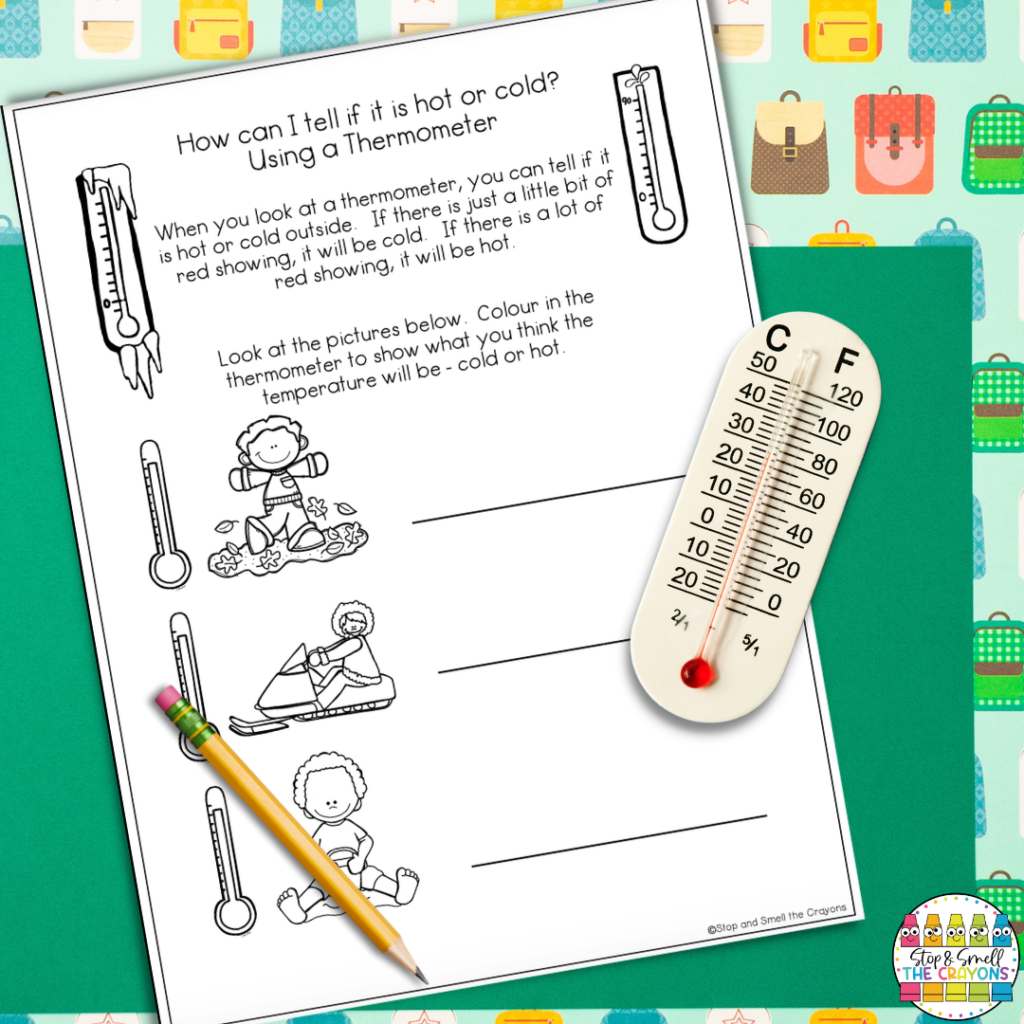
They are such a meaningful way to show your students the concepts you have been learning about. Through hands-on experiences, students can observe and investigate the changes that occur in the environment around them and are more likely to understand and remember what you are teaching.
Need a few ideas to get you started using Seasonal Changes experiments? Try these:
- Draw your shadow in the morning and then draw it again in the afternoon. Did it change? Did it move? Discuss with your students what could have happened.
- Place a piece of construction paper in the sun and wait a week. Ask your students what happened to the paper. Make a guess as to why it happened.
- Place a thermometer in direct sunlight and one in a dark classroom corner. Wait an hour and compare the temperatures. Discuss what happened.
Your students will be so excited to see these “magical” things happening before their very eyes! Not only will your students enjoy the results of their experiments, but they won’t soon forget what they learned. It’s no trick though! Just science!
Are you excited to teach Daily and Seasonal Changes yet?
I hope so! It truly is easier than you think to teach your students about Daily and Seasonal Changes. No complicated equipment is necessary. Just use what you already have and your creative Teacher Brain!
If you loved the creative ideas and resources that my “creative Teacher Brain” shared in this Blog Post, check out the print-and-go pages in my Four Seasons and Seasonal Changes 1st Grade Science Unit available in my TPT Store! This unit has printable student pages and lesson plans to teach many of the ideas that I mentioned in this post! If you are looking for printable activities, beautiful Power Point slides, illustrated word cards, and lesson plans ready to go, then this unit is a must-have for your Science class!
Head on over to my TPT Store to grab these ready-to-go resources for teaching Daily and Seasonal Changes. Your students will have so much fun with these activities and you will cut your planning time down to practically nothing!
If you are looking for more engaging and hands-on science resources for first grade, check out these blog posts filled with practical and ready to use classroom ideas.
- Energy in Our Lives
- Needs and Characteristics of Living Things
- Materials, Objects, and Everyday Structures
Save these Ideas for Teaching Daily and Seasonal Changes
Pin this to your favorite classroom science Pinterest board so you can come back for these easy ways to make teaching Daily and Seasonal Changes fun for your students!
And be sure to grab this Free Daily and Seasonal Changes Checklist. While this is created for the Grade 1 Ontario Science Curriculum, it can be used by anyone! Simply click on the image below to download.
More Grade 1 Science Resources
If you are looking for more engaging and hands-on science resources for first grade, check out these blog posts filled with practical and ready to use classroom ideas.
- Energy in Our Lives
- Needs and Characteristics of Living Things
- Materials, Objects, and Everyday Structures
Save these Ideas for Teaching Daily and Seasonal Changes
Pin this to your favorite classroom science Pinterest board so you can come back for these easy ways to make teaching Daily and Seasonal Changes fun for your students!
